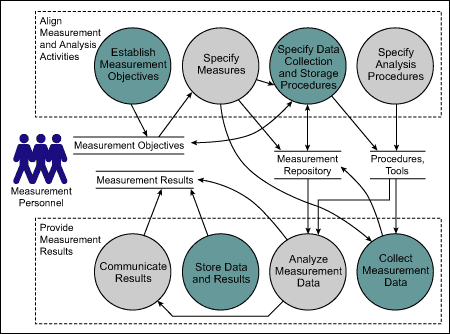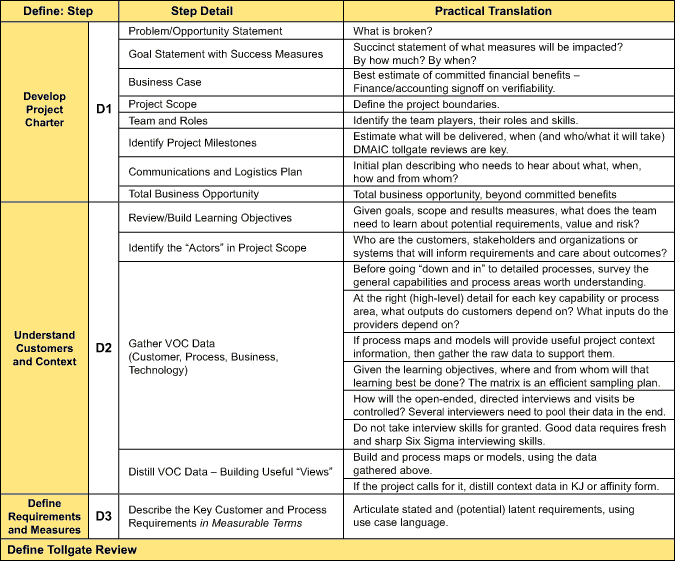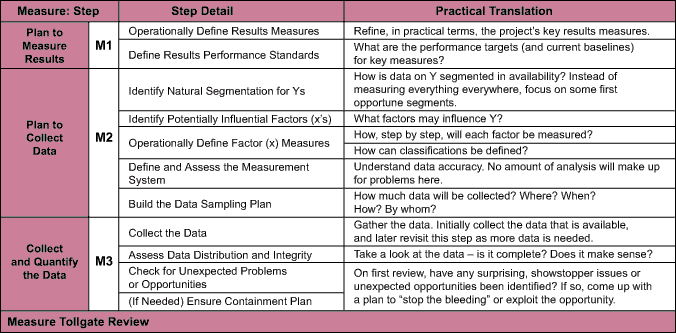
Measurement and analysis (MA) is a Level 2 support process area within the Capability Maturity Model Integration (CMMI) process. The purpose of MA is to provide management information necessary to implement monitoring and control of various required processes.

Source: Ahern, Clouse and Turner, CMMI Distilled: A Practical Introduction to Integrated Process
Improvement, second edition, Addison Wesley 2004. © 2002 Carnegie Mellon University
As with other process areas of the CMMI, the emphasis is on what should be done, not how to do it. That is where Six Sigma makes a strong connection to MA (and to some of the other process areas). It supplies a specific and proven answer to the “how” question – a methodology for applying measurement and analysis to problem solving. Two points of view must be taken into account in the exploration of this issue in relation to software projects:
- That of the software project being executed, which clearly has a certain set of needs related to measurement and analysis, with primary emphasis on getting the job done on budget, on schedule and with the required quality.
- That of those concerned with process improvement, with emphasis on understanding and improving process efficiency and effectiveness.
While complementary and overlapping, each point of view has its own needs. The application of the DMAIC flavor of Six Sigma aligns with the process improvement context of CMMI MA, while Design for Six Sigma (DFSS) typically is more closely tied to the project execution viewpoint, and illustrates other connections between MA and Six Sigma.
Establish Measurement Objectives
This first MA process area step aligns closely with the Define phase in a Six Sigma DMAIC project that has been chartered to improve a specific aspect of performance. Here is the first important distinction and value-add that comes from the conjunction of Six Sigma and CMMI. Six Sigma places primary emphasis on understanding and managing performance (outcomes) while CMMI (in practice if not in principle) places more emphasis on compliance (activities). Certainly both are necessary and important, but neither is sufficient by itself. The Six Sigma roadmap provides a specific approach to establishing the overall objectives and identifying potential measures for an improvement project as illustrated in Table 1.

- Table 1
Specify Measures and Data Collection
The second and third steps in the MA process area align closely with the Measure phase of DMAIC. Again, the Six Sigma roadmap in Table 2 provides detailed guidance for how to conduct these activities.

Specify Analysis Procedures and Analyze Measurement Data
The Analyze phase of DMAIC encompasses the activities envisioned by these steps of the MA process area. Six Sigma training includes instruction in selection and application of appropriate statistical tools, including criteria for determining which tools and methods are most applicable to a particular situation. Again, the roadmap provides detailed guidance on how to proceed, as shown in Table 3.vAs with all methodologies, “brain engaged” is necessary to success. For convenience these roadmaps are presented as though sequential, while in practice iteration is both common and appropriate.
Improvement Process Areas
The MA process area interacts with and supports three other key process areas that embody improvement activities:
- Causal analysis and resolution
- Organizational process performance
- Organizational innovation and deployment
These process areas of CMMI align closely with the Improve phase of DMAIC, as described in Table 4.The Control phase of a Six Sigma DMAIC project is in one sense a bridge back to the project point of view. As seen in Table 5, the Control phase aligns most closely with CMMI generic practices (GP) 2.8 and 3.2:
GP 2.8 – Monitor and control the process against the plan for performing the process and take appropriate corrective action.
GP 3.2 – Collect work products, measures, measurement results and improvement information derived from planning and performing the process to support the future use and improvement of the organization’s processes and process assets.
Both Six Sigma and CMMI are powerful, broad in scope and multifaceted. There are many valid ways to understand them and describe their synergy
Editor’s Note: Author Gary Gack has participated as a research affiliate in a collaboration with the Software Engineering Institute’s Software Engineering Measurement and Analysis (SEMA) group and others in creation of a new course to be offered by the institute. For a more in-depth discussion of this topic, see Siviy, Jeannine, M. Lynn Penn, “Relationships Between CMMI and Six Sigma,” CMU/SEI-2005-TN-005, publication pending. As always, readers are invited to join the author and others in the discussion forum to share perspectives and insights into any issue raised about this subject or any others.